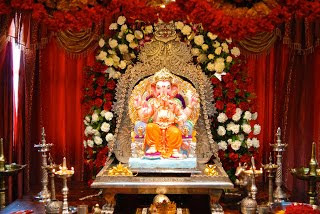Although it is unknown when Ganesh Chaturthi was first observed, the festival has been publicly celebrated in Pune since the era of Shivaji The Peshwas encouraged the celebrations in their capital, Pune, since Ganesha was their family god With the fall of the Peshwas, the Ganesha festival lost state patronage and became a private family celebration in Maharashtra until its revival by Indian freedom fighter and social reformer Lokmanya Tilak.
The current Maharashtra public festival was introduced in 1892 by Bhausaheb Laxman Javale , who installed the first sarvajanik (public) Ganesha idol after he met with Balasaheb Natu and Krishnajipant Khasgiwale at his home. When he visited the Maratha-ruled state of Gwalior, Khasgiwale saw the traditional public celebration and brought it to the attention of his friends in Pune.In 1893 Tilak praised the celebration of sarvajanik Ganesha utsav in his newspaper, Kesari, and the following year he installed a Ganesha idol in the Kesari office; his efforts transformed the annual domestic festival into a large, well-organised public event. Tilak recognized Ganesha's appeal as "the god for everybody", popularising Ganesh Chaturthi as a national festival to "bridge the gap between Brahmins and 'non-Brahmins' and find a context in which to build a new grassroots unity between them", generating nationalistic fervour in the Maharashtran people to oppose British colonial rule. He was the first to install large public images of Ganesha in pavilions, and established the practise of submerging the idols in rivers, the sea or other bodies of water on the tenth day of the festival.
Encouraged by Tilak, Ganesh Chaturthi facilitated community participation and involvement in the forms of intellectual discourse, poetry recitals, plays, concerts, and folk dances. It was a meeting ground for people from all castes and communities at a time when the British discouraged social and political gatherings to control the population.
In Goa, Ganesh Chaturthi predates the Kadamba era. The Goa Inquisition had banned Hindu festivals, and Hindus who did not convert to Christianity were severely restricted. However, Hindu Goans continued to practice their religion despite the restrictions. Many families worship Ganesha in the form of patri (leaves used for worshiping Ganesha or other gods), a picture drawn on paper or small silver idols. In some households Ganesha idols are hidden, a feature unique to Ganesh Chaturthi in Goa due to a ban on clay Ganesha idols and festivals by the Jesuits as part of the Inquisition.Unlike the Maharashtra festival, Ganesh Chaturthi is more of a family affair; gatherings of 1,000 or more celebrate the festival in their ancestral homes.












0 comments:
Post a Comment